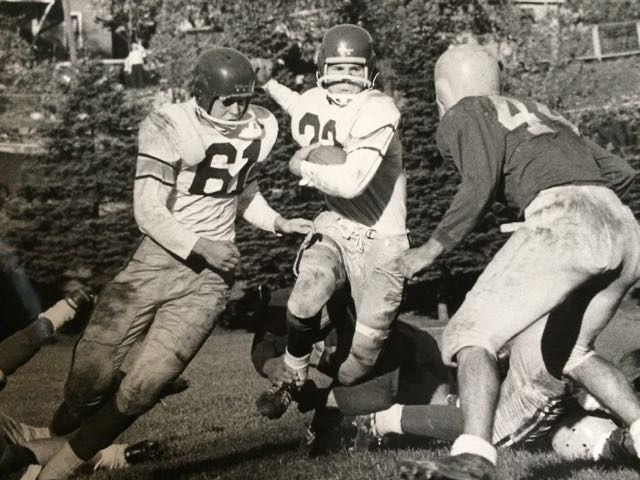
Halfback Fox about to fall head first during highschool ankle tackle. (Submitted photo)
My first football related brain trauma occurred when I was seventh grader playing on the Saint Sebastian grade school football team in Milwaukee. I was the quarterback and dived into the end zone from the one-yard line. Don’t remember if I scored. Everything went blank at that moment.
I woke up on the sideline. An ambulance had already been called. Within minutes I was in a hospital bed still in my red uniform.
I had landed on my head and was knocked unconscious.
Two years later I continued playing football at Marquette University High School where I am pleased to say we won the state championship. There would be more injuries, mostly sprains and pulled muscles. My head got knocked around as well. We didn’t talk about concussions back then. Sometimes I got dizzy after a blow to the head, but we had all learned that for the sake of the team to get back into the game as soon as we could. That was just part of being “macho”; it came with the game.
Not finished yet, I went on to Stanford University on a football scholarship. The players were bigger; the blows to the body more intense. But, heck, that’s college football.
There's more to NCR than what you read online. Subscribe today!
My football career came to an end after I had a parting of the ways with varsity football coach Jim Ralston. I had been invited by a Stanford dean to do voluntary work in Hong Kong. Ralston told me one day I had to decide between football and Asia. Well, that was that. Fortunately, by then I was eligible for an academic scholarship. Pun not intended: it was a no brainer — and the end of my football days.
I was spared further football brain trauma and, apparently, so far, have experienced no permanent football related debilitating brain damage.
My late brother-in-law, Wally Hilgenberg, who married my younger sister, Mary, was not so fortunate. He played college football at Iowa and went on to play 16 seasons of professional football, most of these for the Minnesota Vikings.
Wally died in 2008 at age 66. The preliminary diagnosis for his death was amyotrophic lateral sclerosis (ALS), better known as Lou Gehrig's disease; however, a brain autopsy later revealed he had died from repetitive brain trauma suffered while playing football.
We are told athletic equipment is made with safety in mind. But the doctors who studied Wally’s brain had other thoughts. They said the hard outer shells of football helmets today avoid fracturing skulls. They absorb shock. But the human brain rests in a gel and is shaken violently inside the head with each blow. One doctor suggested the decades-old leather helmets might have actually been safer as the pain of a crack to the head would regulate playing habits. Maybe; maybe not. But clearly football remains a dangerous sport. And brain injuries can be the most subtle and lethal of all the injuries.
I watched my sister and her family care for Wally as he began to lose the ability to walk, then to move his arms and hands. Eventually confined to a wheelchair he lost his ability to speak and, finally, to breathe.
Memories of Wally’s death remain vivid. They often return to me at the oddest times. I thought of Wally the other day when I heard the news that Notre Dame starting quarter back, Malik Zaire, had fractured an ankle and would be out for the season. I know how disappointed he must be and what a blow it is to Notre Dame’s chances for a “golden” season and a shot at the national championship.
But my thought the other day was that Zaire’s ankle fracture might well have been a blessing in disguise, and it might one day prove to have added some years to his life.
I don’t know how football can be played as it is currently and yet find the means to protect young athletes. I understand the lure of money and fame. For some young athletes it’s the only visible path out of poverty.
Nevertheless, the way young athletes are pressured to play for the profit of others — college football is big, big business — is a form, it seems, of abuse, in some cases possibly child abuse.
We are a long way from thinking this way at the moment, I know. I don’t know if we will ever get there given football’s widespread interest and financial success. The average professional football team is worth $2 billion. National Football League Commissioner Roger Goodell reportedly was paid $44 million in 2012. Not long ago the Notre Dame football program received a $10 million gift from real-estate developer Richard Corbett to endow its football coach position.
My sister Mary, meanwhile, keeps me abreast with conversations with and visits to the hurting wives of dying former professional football players, men who have lost their ability to function and think. Mary continues to attend the funerals of the husbands of NFL widows. The numbers of early bodily deterioration and deaths are mounting. Word is bound to spread.
It bothers me that Catholic university football programs are not under serious review by Catholic university presidents. Will they one day be viewed as having been seriously negligent, just as the U.S. bishops are viewed today as having covered up and facilitated child abuse?
We will continue to learn more about football brain trauma. Rules will be tweaked, if for nothing else than the appearances of making the sport safer. Maybe those changes will be enough to protect young athletes and provide salve to the consciences of football enthusiasts and profiteers.
However, Mary and other football widows are not going away — and their numbers are growing. Given what these women are experiencing we are clearly not protecting our young athletes. Is anybody listening?


